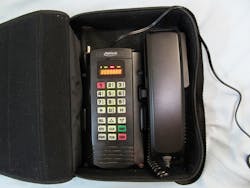Download this article in PDF format.
Much is being written and imagined about the many capabilities of future wireless-communications systems and reaching into higher frequency ranges. But current wireless systems are based on well-conceived standards, which have worked for many applications, from simple radio-frequency identification (RFID) tags for tracking goods in warehouses to more elaborate 4G Long Term Evolution (4G LTE) cellular wireless systems. 5G cellular technology may be coming, but existing standards define quite a bit of wireless-communications technology that already works quite well.
Wireless standards organize radio waves into separate spaces, from the shortest-distance personal area networks (PANs) to longer-distance satellite-communications (satcom) systems, so that those radio waves coexist with minimal interference. Scientific organizations like the IEEE and the International Telecommunications Union (ITU) develop wireless standards for different technologies and applications, for compatibility and efficiency.
Many different working groups may exist within one organization. These include the many IEEE 802.11 wireless local-area-network (WLAN) working groups for different forms of short-range WLAN communications systems, including at mmWave frequencies (the IEEE 802.11ad working group).
The IEEE’s working groups lend tremendous support to the continuing development of wireless standards for many different applications. For example, the IEEE 802.11 working group is focused on the enhancement of WLAN technologies and systems, while the IEEE 802.15 working group is devoted to wireless specialty networks. Standards developed by this latter working group include IEEE 802.15.4-2015 for low-power, low-data-rate WPANs and IEEE 802.15.3e.2017 for high-data-rate, multimedia wireless networks, including close-proximity point-to-point communications. For higher frequencies, IEEE 802.15.3c-2009 defines wireless networks capable of data rates in excess of 5 Gb/s using the 60-GHz band.
In many cases, wireless-communications standards are managed by industry groups or forums, such as Bluetooth short-range wireless devices from 2.400 to 2.485 GHz. Initially developed as part of an IEEE standard (IEEE 802.15.1), it’s managed by the Bluetooth Special Interest Group (SIG), which boasts more than 30,000 companies as members. Bluetooth is among the most popular short-range wireless standards, replacing cables in many applications.
Similarly, Worldwide Interoperability for Microwave Access (WiMAX) is a family of wireless standards developed by the WiMAX Forum. Based on IEEE 802.16 wide-area-network (WAN) communications standards, WiMAX is one of the most popular wireless WAN standards for various “last-mile” wireless applications, including wireless sensor networks.
By now, all wireless standards are digital, and a common trend is for higher data rates for fixed or mobile communications in whatever bandwidth is available. This need of bandwidth in support of higher data rates has pushed operating frequencies higher, where bandwidths are available. Wireless cellular systems provide a good example of this trend, moving from the sub-1-GHz frequencies of the first-generation analog advanced mobile phone service (AMPS) wireless systems to the multiple-frequency bands of 5G cellular wireless networks, including at millimeter-wave (mmWave) frequencies.
Wireless Evolution
Early wireless standards such as AMPS were relatively inefficient in their use of bandwidth, employing 30-kHz-wide channels in the 800-MHz band. One of the first wireless mobile telephone standards, the Nordic Mobile Telephone (NMT) service developed for Norway, Sweden, and Denmark, made use of two different frequency bands in its 450-MHz NMT-450 and 900-MHz NMT-900 variants. Many industry and standards organizations have grown throughout the years in support of different wireless cellular telephone standards, such as the Third Generation Partnership Project (3GPP) and its work in aiding the growth of 3G and 4G wireless telephone standards.
As the number of carriers and subscribers expanded, the need for bandwidth would increase. This, in turn, required enhancements in modulation, multiple-access schemes, and digital switching in subsequent generations of cellular communications standards through current 4G Long Term Evolution Advanced (LTE-A) systems. The steady rise to the now billions of worldwide wireless mobile telephone subscribers has led to the somewhat accelerated development of high-speed, high-frequency 5G wireless systems.
Early mobile cellular telephones used analog transmission techniques in 1G systems, switching to digital switching in the following generation. (Courtesy of Wikipedia)
Advances in mobile wireless telephone hardware have followed the evolution of cellular standards and their base stations, from large and power-hungry to much smaller, more energy-efficient units with increased computer processing power. Early briefcase-sized mobile telephones (see figure) were designed more for use in automobiles than to be carried, and the aggressive power consumption led to extremely short battery recharge cycles.
Those early wireless-communications devices have evolved along with the wireless standards and networks, to the current, microprocessor-managed “smart” wireless systems that double as memory banks and portable computers for many users. A brief comparison of cellular telephone standards shows how data rates have increased even as the size of mobile telephones continues to shrink (Table 1). The most drastic development when moving to the second generation was the change from analog to digital transmission/reception techniques, which also gave rise to the availability of the short-message-service (SMS) function in 2G cellular systems.
The transition from 1G AMPS to 2G cellular systems became known for its change from analog to digital transmission protocols, including code-division multiple access (CDMA) and Global System for Mobile Communications (GSM), a time-division multiple-access (TDMA) scheme in which radio transmissions are broken into different time slots. Techniques such as TDMA and frequency-division multiple access (FDMA) in 2G cellular standards sought more-efficient use of spectrum than in analog AMPS systems.
Searching for Spectrum
Bandwidth is a precious commodity for any wireless network and available bandwidth tends to be fragmented. Thus, many wireless carriers wind up with “collections” of frequency spectrum that’s scattered depending on geography.
The fragmented radio spectrum and continuing quest for higher data rates in wireless standards has encouraged the development of innovative transmission protocols over the years, such as FDMA and TDMA. In addition, wireless network infrastructure has made use of novel design approaches. For example, multiple-input, multiple-output (MIMO) antenna architectures enable the use of beamforming techniques to achieve signal connections even in noise environments, serving simultaneous wireless users without sacrificing data rates.
Later cellular communications standards, such as 4G LTE-A, have also made use of carrier aggregation to combine radio channels and create wider effective bandwidths from the bits and pieces of spectrum, even if they are not continuous. Newer cellular standards such as 3G and 4G have incorporated smaller, closely spaced cells as well. Equipped with smart signal switching, they compensate for growing demands for faster data communications even with limited frequency spectrum resources.
As part of the development of worldwide 5G wireless standards, the IEEE 5G Initiative is compiling a massive database related to 5G technology and applicable standards that will be available via internet access at the IEEE website. In addition, the organization is inviting online feedback at [email protected] for those wishing to contribute to the development of 5G wireless standards.
Wireless standards differ in terms of communications distance and power, from far-reaching cell- and satellite-based systems to lower-power wireless standards such as single-building WLANs. The IEEE’s set of 802.11 WLAN standards are probably the world’s most widely followed wireless computer networking guidelines. They’re supported by additional nonprofit organizations such as the Wi-Fi Alliance, which helps certify the compliance of new electronic products to IEEE 802.11 standards.
The latest generation of consumer and commercial Wi-Fi products claimed to meet IEEE 802.11ax requirements have been branded as Wi-Fi 6—the sixth generation of Wi-Fi (Table 2). Prior to Wi-Fi 6, previous generations of Wi-Fi technology have been Wi-Fi 5, which embodied IEEE 802.11ac technology, and Wi-Fi 4, aided by IEEE 802.11n technology.
About the Author
Jack Browne
Technical Contributor
Jack Browne, Technical Contributor, has worked in technical publishing for over 30 years. He managed the content and production of three technical journals while at the American Institute of Physics, including Medical Physics and the Journal of Vacuum Science & Technology. He has been a Publisher and Editor for Penton Media, started the firm’s Wireless Symposium & Exhibition trade show in 1993, and currently serves as Technical Contributor for that company's Microwaves & RF magazine. Browne, who holds a BS in Mathematics from City College of New York and BA degrees in English and Philosophy from Fordham University, is a member of the IEEE.




